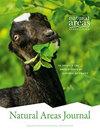鹿和林缘对林下植物群落的影响
IF 0.8
4区 环境科学与生态学
Q4 ECOLOGY
引用次数: 1
摘要
摘要:白尾鹿通过改变植物群落组成和结构,影响东部落叶林的生态完整性。先前的研究表明,过多的鹿会对木本和草本植物的吸收和持久性产生负面影响。然而,这些相互作用的强度和性质可能取决于栖息地的环境。森林边缘为鹿和许多引入的植物物种提供了有利的栖息地,并有可能改变鹿影响的性质。在这里,我们探讨了森林边缘是否影响了鹿对森林景观中植物群落的影响。具体来说,我们排除了鹿,或者,允许鹿进入两个北部硬木林边缘和内部的地块。这些森林中鹿的数量约为每平方公里6-12只。经过八年的排斥,我们调查了地块内的植物群落,以评估鹿对整个森林景观中植物群落组成的影响。我们发现,鹿在森林中的栖息地环境中的影响是强烈的,对本地和引进物种的覆盖率和丰富度的影响相对较弱。另一方面,边缘栖息地对本地物种和引进物种以及木本和草本物种的覆盖率都有很大影响,但这些影响的程度在两个森林地区各不相同。这项工作表明,鹿在密度相对较低的情况下可能会产生适度的影响,而且这些影响在不同的森林栖息地类型中是一致的,而森林破碎化和随后产生的边缘栖息地可能是森林下层组成的重要驱动力。本文章由计算机程序翻译,如有差异,请以英文原文为准。
Effect of Deer and Forest Edge on Understory Plant Communities
ABSTRACT White-tailed deer (Odocoileus virginianus) impact the ecological integrity of eastern deciduous forests by modifying plant community composition and structure. Previous studies have shown that overabundant deer can negatively impact the recruitment and persistence of both woody and herbaceous plants. However, the strength and nature of these interactions can depend on habitat context. Forest edges provide favorable habitat for deer along with many introduced plant species, and have the potential to modify the nature of deer impacts. Here, we explore whether forest edges shape the impacts of deer on plant communities within the forest landscape. Specifically, we excluded deer, or, alternatively, allowed deer access, in plots along the edge and within the interior of two northern hardwood forests. Background deer abundance in these forests was approximately 6–12 individuals per km2. After eight years of exclusion, we surveyed plant communities within plots to assess the impacts of deer on plant community composition across the forested landscape. We found that the impacts of deer were robust across habitat context within the forest, with relatively weak impacts on cover and richness of both native and introduced species. Edge habitat, on the other hand, had strong impacts on cover of both native and introduced species, as well as woody and herbaceous species, but the magnitude of these impacts was variable across the two forest sites. This work suggests that deer can have modest impacts when at relatively low densities, and that these effects can be consistent across forest habitat types, while forest fragmentation and subsequent generation of edge habitat can be an important driver of composition in the forest understory.
求助全文
通过发布文献求助,成功后即可免费获取论文全文。
去求助
来源期刊

Natural Areas Journal
环境科学-林学
CiteScore
1.70
自引率
11.10%
发文量
50
审稿时长
>36 weeks
期刊介绍:
The Natural Areas Journal is the flagship publication of the Natural Areas Association is the leading voice in natural areas management and preservation.
The Journal features peer-reviewed original research articles on topics such as:
-Applied conservation biology-
Ecological restoration-
Natural areas management-
Ecological assessment and monitoring-
Invasive and exotic species management-
Habitat protection-
Fire ecology.
It also includes writing on conservation issues, forums, topic reviews, editorials, state and federal natural area activities and book reviews. In addition, we publish special issues on various topics.
 求助内容:
求助内容: 应助结果提醒方式:
应助结果提醒方式:


